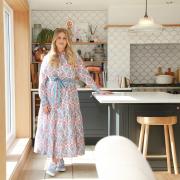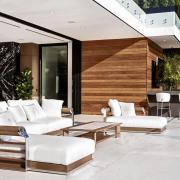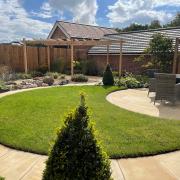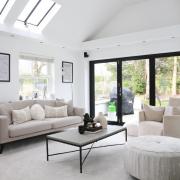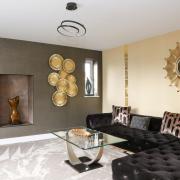When creativity and entrepreneurialism are in the DNA, what to do but establish a world-leading furniture-making company? Kate Houghton meets Mark Boddington, founder of Silverlining Furniture
Ah, you say, Boddington – that’ll be the brewery, then. And you’d be right. Kind of. Mark Boddington, founder of Silverlining Furniture Group, which crafts seriously beautiful, unique designer furniture from a base in Wrexham, is the great-grandson of Henry Boddington, founder of Manchester’s famous Boddington Brewery. Henry was renowned for his entrepreneurial acumen and hard-working nature, and took his brewery to great heights, succeeded by his sons and his grandson. Mark inherited this entrepreneurial acumen and a familial love of art.

‘My maternal great-grandfather was a very successful entrepreneur who went into banking and was in fact the first man to set up his bank to have different franchised branches, which he did throughout the country and which eventually became the Midland Bank. He was a great collector of Pre-Raphaelite art, and Henry Boddington was a big collector of Arts & Crafts furniture and supported the Century Guild of Artists, which was set up in 1882 by a collection of northern artists who, after the industrial revolution, were concerned that craft and creativity would disappear with automation.
‘The third seed was my mother. She was 12 when the Second World War started and was a real self-starter; she never went to school, she taught herself everything – she did her own upholstery, she was an incredible cook, a brilliant seamstress. My father went to the brewery and my mother was there as a creative mentor, really.

‘I had always made objects in wood from a very early age – I made a bookcase with my mother (just nailed together) when I was five. At school I won all the woodworking prizes and really it was an innate passion. I didn’t get the A Levels I needed to go to university – I was meant to go to Reading to study land management, and then in theory join the family business – but my sister, rather bravely, said to me “why don’t you do what you love?”.’
Mark’s father was supportive of his wish not to enter the family business, and Mark achieved a place with furniture maker John Makepeace, attending the same training school as David Linley, now the second Lord Snowdon.

‘At 21 I decided to set up my own business. I came home to Cheshire and wrote to all the country house owners – the Grosvenor Estate, Bolesworth, Arley, Capesthorne, Chomondeley, etc. This led me to finding some old buildings on the Grosvenor Estate, in Aldford, and the landlord, of course, was the late Duke of Westminster. I started working for the family, who in 1988 began planning the renewal of Eaton Estate, on which I did a lot of work with Her Grace the Duchess. Through Her Grace we met other aristocratic families and then worked with a family who lived in London but had a lot of American relatives, which took us over there, too.’
The USA is still Silverlining’s biggest market for domestic pieces, and Silverlining has created bespoke pieces for clients from East Coast to West, including unique works for famous names as Tom Ford, Kevin Costner, Madonna and David Bowie, but an introduction to a boat designer introduced a whole new direction for Mark to take – superyachts. Mark’s business is now split fairly evenly between residential and superyacht furniture design, with a small slice devoted to private aircraft interiors. What unites the different aspects of the business is that each commission is wholly unique, designed and crafted precisely to the client’s desires and, of course, priced accordingly. In the commissioning of one-off pieces of functional art from one of the world's best and most imaginative furniture makers, budgets are generous.

‘In everything we do, we push boundaries,’ he says. ‘Our clients can’t find what we do anywhere else. We use technology and nature and science to push those boundaries on every commission. We study nature under the microscope for colours and shapes. Our inspiration can come from the cosmos, it can come from a landscape – we're very connected to nature and we also study pushing boundaries with finishes and structures.
'We have a lot of lasers here, we have CNC (computer numerical control) technology, 3D printers. We use technology to enable us to advance craftsmanship. For example, with a laser we can do marquetry at a microlevel – which you could do by hand, but it just wouldn’t be as accurate and would take months. We also collaborate with universities such as the bio-composite centre at Bangor, looking at green and sustainable finishes. We developed a technique where we can dye wood any Pantone colour. We can use AI to create an algorithm to create a specific finish using our tech. We have developed a selection of samples we take around the world to show what we can do.
‘It’s taking the best of ancient skills and adding contemporary techniques.

‘When I started, people used to think there were three wood finishes – light, mid and brown oak, but it’s actually incredible what you can do. We work in a variety of materials – straw, leather, metallised resin, stone, mother of pearl, glass, and so on.
‘One of the things I love is taking very pure, traditional materials, and changing expectations around them. We use the very sustainable European oak, but then can change the finish of it to whatever we want – we can oxidise it white, with salt, or burn using heat, a technique taken from traditional Japanese cabinetry. So, it’s using history and knowledge of craftsmanship in the past and combining that with modern techniques and advanced materials to push boundaries.
‘There are hundreds of great furniture makers in the UK, but I think our success is that we’re at the cutting edge of what craftsmanship is today.’
As part of Mark’s focus on legacy – not just for his business, but for the crafts, skills and techniques his furniture demands – he has established a clear focus on bringing young people into the industry and providing a clear path for growth and progression.

‘Even when furniture makers join us, they need another five years to make senior cabinet maker. We bring in apprentices at three levels – some who are starting from scratch, who may have done some joinery at college; trainees – who have done some work for someone else and an apprenticeship elsewhere, or have been to a specialist furniture-making college, or private training school and junior furniture makers who are ready to move to the next level.
‘It takes eight years to make senior cabinet maker, and that’s fast track. We really have longevity here, with people training and staying with us, so we have an immense skill set here and a huge range of technical skills to learn too.
‘An apprentice furniture maker will work with a team of four people, then progress to junior then senior cabinet maker, then can become a team leader or workshop foreman, as our set-up is multiple small workshops rather than one single one. Then they can learn draughting, become an engineer, move into the office, become a project manager, because now they have all the skills to take a project from brief to completion. So, it’s a real career path, and we need people to come in at the bottom to then come out at the top, because we’re so specialist we really struggle to bring people in from other industries or businesses; they just don’t know enough.

‘I am 60 now, but we have a great young team here. For me it’s all about legacy – building something that will last and last. We create museum-quality pieces and send 98 per cent of what we make overseas.’
Looking back, Mark is clear that success lies in passion – for what you can do, and how far you can take it, just as his ancestors felt.
‘When I started this, the attitude from some friends of the family was a bit shocking, looking down their noses at someone who had gone into a ‘trade.’ Steve Jobs gave a talk about the things that really matter in the world, and one of them was passion. If you’re passionate about something, you’ll be successful. And what I have done is follow my passion and stick at it, and now we’re giving this opportunity to the next generation who want to follow their passion.’
silverliningfurniture.com

Sharing the skills
As part of his planned legacy, Mark has launched the Silverlining Academy of Skills
‘The Silverlining Academy of Skills is a new training programme teaching ‘Ph.D. level’ craftsmanship techniques,’ Mark says. ‘The programme will provide theoretical knowledge and hands-on practice of 21st-century craftsmanship skills such as finishing, cabinet making, laser marquetry, CNC programming and operation and leatherwork. Trainees will be recognised by receiving a competitive remuneration and benefits package from the start.
‘Each fast-track course will take either six or 12 months, dependent on the skill taught and any previous experience. It will consist of 16 hours of theoretical learning and 40 hours of practical training per month. The remaining time will be spent honing the practical skills on sample projects.’
The academy launched in 2021, with four groups of trainees completing cabinet making, straw craftsmanship, finishing and leather skills courses. People from all walks of life can apply to join the academy by sending their CV to enquiries@silverliningfurniture.com.

Artistry
When creating Silverlining’s artworks and furniture, the talented artisans Mark has gathered combine age-old hand techniques with advanced manufacturing. They call it the ‘Silverlining twist’, transforming natural materials into something magical.
Cabinetry
Milling | jointing | planing | sawing | computer numerically controlled routing, shaping and moulding | laser cutting | 3D printing |carving | veneering | sanding | polishing
Leathercrafting
stitching | repoussé| planishing | veining and chasing | stack laminating and carving | embossing







